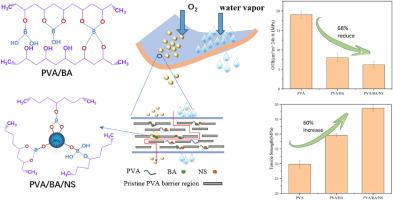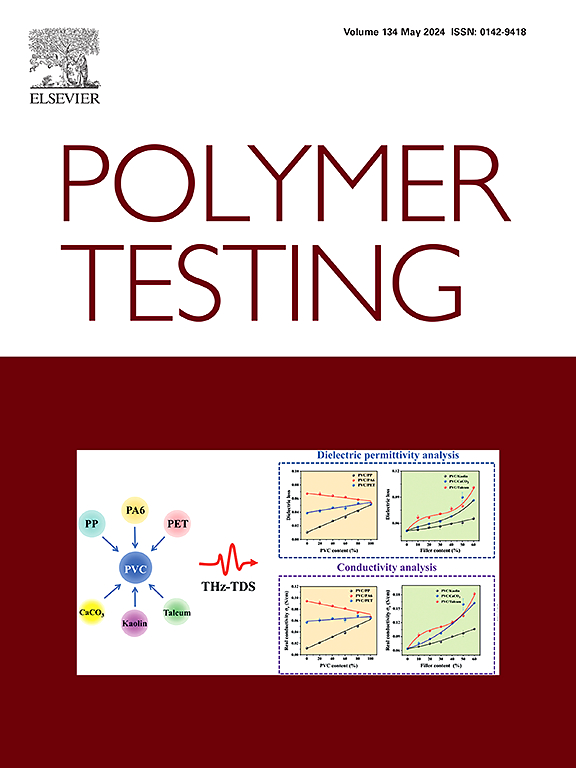Synergistic reinforcement of PVA films with boric acid and nano-silica for high-barrier food packaging
IF 6
2区 材料科学
Q1 MATERIALS SCIENCE, CHARACTERIZATION & TESTING
引用次数: 0
Abstract
The increasing environmental crisis caused by the extensive use of disposable plastics highlights the pressing demand for sustainable options. This research investigates an innovative method for enhancing the traits of polyvinyl alcohol (PVA) through the addition of boric acid (BA) as a crosslinking agent, along with γ-aminopropyl triethoxysilane modified nano-silica (NS) to refine the polymer matrix. The research focuses on the PVA/BA/NS composite film, examining its chemical structure, surface morphology, thermal stability, mechanical strength, gas barrier properties, surface wettability and UV-blocking ability. The results demonstrate that the overall performance of the composite film is significantly enhanced through the synergistic effects of boric acid (BA) and NS, achieved via crosslinking, nanofiller reinforcement, and structural optimization. The PVA/BA/NS composite films shown notable improvements in oxygen, water vapor barrier qualities, and mechanical strength. Furthermore, the addition of nano-silica greatly improved the films' surface hydrophobic qualities, improving their suitability for food packaging. Notably, the tensile resistance of the composite film improved by about 60 % relative to the PVA film, exceeding the findings of comparable research. Additionally, oxygen barrier performance improved by approximately 68 %, highlighting a significant enhancement. Furthermore, it was noteworthy that UV-blocking ability of the composite film had also been markedly enhanced. These improvements are essential for developing food packaging materials that offer better protection and longer shelf life for perishable products, while maintaining quality and safety for consumers. The results convincingly indicate that the environmentally friendly composite films created in this research possess considerable promise for use in food packaging applications.

高阻隔食品包装用硼酸和纳米二氧化硅协同增强PVA薄膜
广泛使用一次性塑料造成的日益严重的环境危机凸显了对可持续选择的迫切需求。本研究研究了一种通过添加硼酸(BA)作为交联剂,以及γ-氨基丙基三乙氧基硅烷修饰纳米二氧化硅(NS)来改善聚乙烯醇(PVA)聚合物基体性能的创新方法。研究了PVA/BA/NS复合膜的化学结构、表面形貌、热稳定性、机械强度、气体阻隔性能、表面润湿性和紫外线阻隔能力。结果表明,硼酸(BA)和纳米填料通过交联、纳米填料增强和结构优化实现协同作用,显著提高了复合膜的整体性能。PVA/BA/NS复合膜的阻氧、阻水蒸气性能和机械强度均有显著提高。此外,纳米二氧化硅的加入大大改善了薄膜的表面疏水性,提高了其在食品包装中的适用性。值得注意的是,与PVA膜相比,复合膜的抗拉性能提高了约60%,超过了同类研究的结果。此外,阻氧性能提高了约68%,显著增强。此外,值得注意的是,复合膜的紫外线阻挡能力也得到了显著增强。这些改进对于开发食品包装材料至关重要,这些包装材料可以为易腐产品提供更好的保护和更长的保质期,同时为消费者保持质量和安全。结果令人信服地表明,本研究创造的环保复合薄膜在食品包装应用中具有相当大的前景。
本文章由计算机程序翻译,如有差异,请以英文原文为准。
求助全文
约1分钟内获得全文
求助全文
来源期刊

Polymer Testing
工程技术-材料科学:表征与测试
CiteScore
10.70
自引率
5.90%
发文量
328
审稿时长
44 days
期刊介绍:
Polymer Testing focuses on the testing, analysis and characterization of polymer materials, including both synthetic and natural or biobased polymers. Novel testing methods and the testing of novel polymeric materials in bulk, solution and dispersion is covered. In addition, we welcome the submission of the testing of polymeric materials for a wide range of applications and industrial products as well as nanoscale characterization.
The scope includes but is not limited to the following main topics:
Novel testing methods and Chemical analysis
• mechanical, thermal, electrical, chemical, imaging, spectroscopy, scattering and rheology
Physical properties and behaviour of novel polymer systems
• nanoscale properties, morphology, transport properties
Degradation and recycling of polymeric materials when combined with novel testing or characterization methods
• degradation, biodegradation, ageing and fire retardancy
Modelling and Simulation work will be only considered when it is linked to new or previously published experimental results.
 求助内容:
求助内容: 应助结果提醒方式:
应助结果提醒方式:


